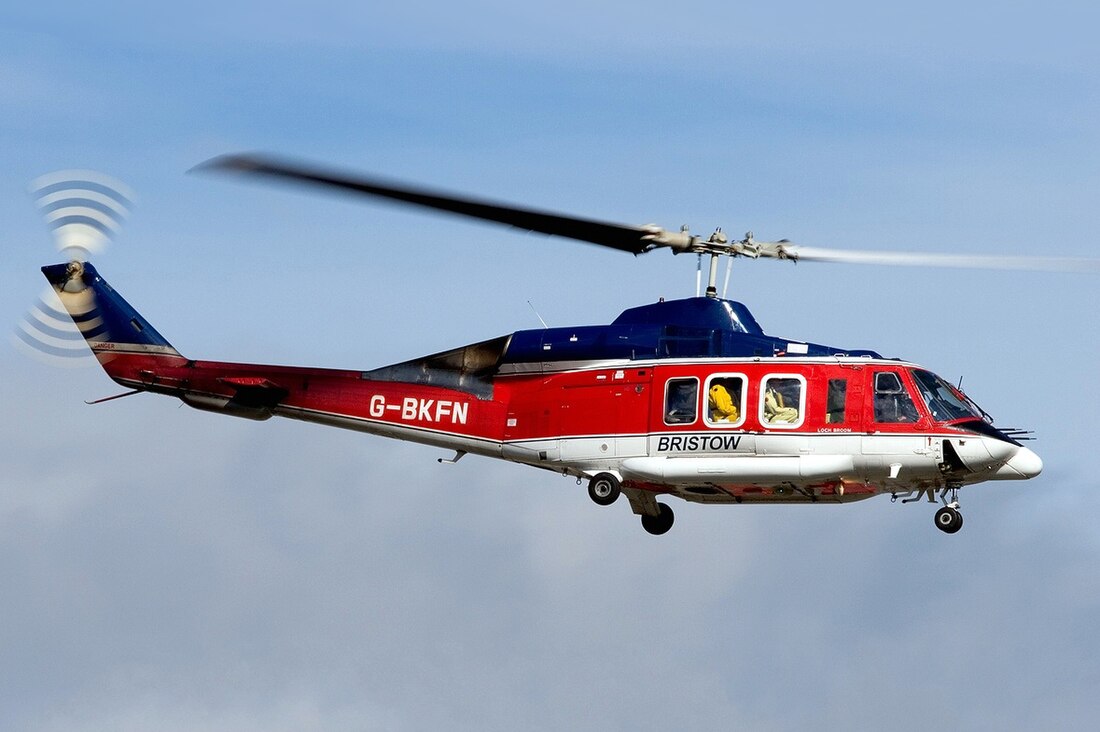Bell 214ST
Helicopter in the US From Wikipedia, the free encyclopedia
The Bell 214ST is a medium-lift, twin-engine helicopter descended from Bell Helicopter's ubiquitous UH-1 Huey series. Though it shares a type number with the somewhat-related Bell 214, the 214ST is larger and of quite different appearance.
| Bell 214ST | |
|---|---|
 | |
| General information | |
| Type | Medium-lift helicopter |
| National origin | United States |
| Manufacturer | Bell Helicopter |
| Status | Production completed |
| Primary users | Peruvian Air Force |
| Number built | 96[1] |
| History | |
| Manufactured | 1979-1993[1] |
| Introduction date | 1982 |
| First flight | 21 July 1979[2] |
| Developed from | Bell 214 |
Design and development
Summarize
Perspective

The Bell 214ST was originally developed as a military project from the Bell 214B BigLifter, specifically for production in Iran and the development by Bell was funded by the Iranian government.[3] The fundamental difference was the replacement of the Model 214's single Lycoming LTC-4 turboshaft engine with two 1,625 shp (1,212 kW) General Electric T700 engines, to improve the helicopter's hot and high performance and improve safety. An interim twin-engine conversion of a Model 214 flew on 15 February 1977 in Texas,[4][5] Testing was successful, and Bell decided to press forward with a definitive twin-engine Bell 214ST, with a fuselage stretched by 30 in (76 cm) and a revised main rotor of greater diameter. Iran changed its production plans, with 50 Bell 214A and 350 214STs to be built at the new production plant to be set up at Isfahan, Iran.[6]
Work started on three conforming prototypes in 1978.[7] The overthrow of the Shah in 1979 resulted in the cancellation of Iran's orders. By this time the new helicopter had attracted sufficient interest from other potential customers for Bell to continue with the project and build the 214ST at their Dallas-Fort Worth facility instead. As a result, it was launched as a civil helicopter, rather than a military one.[3][8][2]

The first of the three full 214ST prototypes flew on 21 July 1979.[2] Manufacturing of production 214STs began in 1981. Type certification from the FAA and CAA for visual and instrument flight rules was awarded in 1982.[9] The military variant followed into production with helicopter deliveries commencing in 1982.[4]
The Bell 214ST included major design changes from the Bell 214. The Bell 214ST has a larger, stretched fuselage with seating for 16-18 passengers,[10][11] and two 1,625 shp (1,212 kW) GE CT7-2A engines.[12] The helicopter introduced some ground-breaking innovations for Bell, including a one-hour run-dry transmission, fiberglass rotor blades, elastomeric rotorhead bearings, and the option of either skid or wheeled landing gear.[3] The helicopter has a cockpit door and a large cabin door on each side. The 214ST has a fuel capacity of 435 US gallons (1,650 L). An auxiliary fuel system could be added.[11]
The Model 214ST was the largest helicopter that had been built by Bell at that time[10] (since surpassed by the Bell 525 Relentless)[13] The ST was originally an acronym for "Stretched Twin", but was later changed to "Super Transporter".[10][12] Bell built a total of 96 214STs with production ending in 1993.[1]
The military operators included Iraq (48),[14] Brunei (1), Peru (11), Thailand (9) and Venezuela (4).
The type certificate for the aircraft is currently held by McDermott Aviation of Queensland, Australia. It was reported online in a March 13, 2025 Aviation Week article that the company intends to restart production "to address global shortfalls in rotary-wing firefighting capability".[15]
Operators
Military operators

Civil operators
- Helicopter Transport Services[18]

Former operators
- British Caledonian Helicopters[9]
- Bristow Helicopters[26][27]
- Petroleum Helicopters
Aircraft on display
United States
Specifications (214ST)

Data from International Directory of Civil Aircraft,[10] Complete Encyclopedia of World Aircraft[7]
General characteristics
- Crew: 1 or 2
- Capacity: Internal: 16 or 17 passengers or equivalent cargo; External: 8,000 lb (3,630 kg) sling load
- Length: 49 ft 4 in (15.03 m)
- Wingspan: 52 ft 0 in (15.85 m)
- Height: 15 ft 11 in (4.84 m)
- Wing area: 2,124 sq ft (107.3 m2)
- Empty weight: 9,481 lb (4,300 kg)
- Max takeoff weight: 17,500 lb (7,938 kg)
- Powerplant: 2 × General Electric CT7-2A turboshaft, 1,625 shp (1,215 kW) each
Performance
- Maximum speed: 143 kn (165 mph, 264 km/h)
- Cruise speed: 140 kn (161 mph, 259 km/h)
- Range: 435 nmi (500 mi, 858 km)
- Service ceiling: 10,400 ft (3,170 m) ; ceiling for hover in ground effect
- Rate of climb: 1,780 ft/min (9.04 m/s)
See also
Related development
Aircraft of comparable role, configuration, and era
References
External links
Wikiwand - on
Seamless Wikipedia browsing. On steroids.
